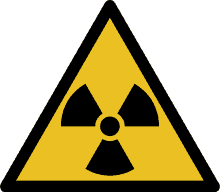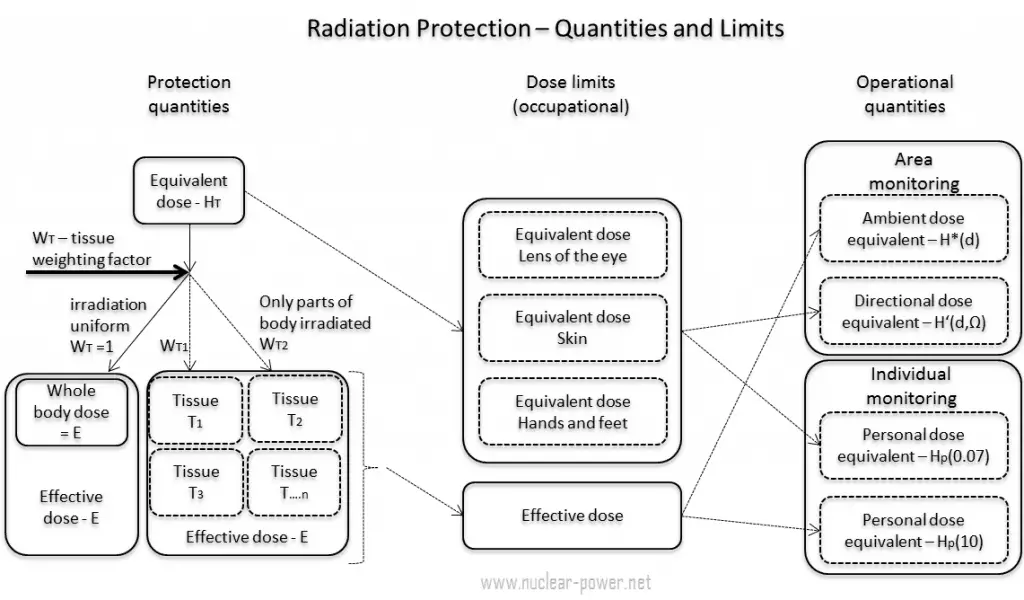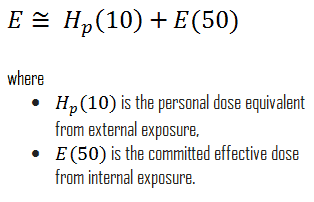
In previous chapters, we described the equivalent dose and the effective dose. But these doses are not directly measurable. For this purpose, the ICRP has introduced and defined a set of operational quantities that can be measured and intended to provide a reasonable estimate for the protection quantities. These quantities aim to provide a conservative estimate for the value of the protection quantities related to an exposure avoiding both underestimation and too much overestimation.
Numerical links between these quantities are represented by conversion coefficients, which are defined for a reference person. An internationally agreed set of conversion coefficients must be available for general use in radiological protection practice for occupational exposures and exposures of the public. Computational phantoms are used for dose assessment in various radiation fields to calculate conversion coefficients for external exposure. Biokinetic models for radionuclides, reference physiological data, and computational phantoms are used to calculate dose coefficients from intakes of radionuclides.
A set of evaluated data of conversion coefficients for protection and operational quantities for external exposure to a mono-energetic photon, neutron, and electron radiation under specific irradiation conditions is published in reports (ICRP, 1996b, ICRU, 1997).
 In general, the ICRP defines operational quantities for the area and individual monitoring of external exposures. The operational quantities for area monitoring are:
In general, the ICRP defines operational quantities for the area and individual monitoring of external exposures. The operational quantities for area monitoring are:
- Ambient dose equivalent, H*(10). The ambient dose equivalent is an operational quantity for area monitoring of strongly penetrating radiation.
- Directional dose equivalent, H’ (d, Ω). The directional dose equivalent is an operational quantity for area monitoring weakly penetrating radiation.
The operational quantities for individual monitoring are:
- Personal dose equivalent, Hp(0.07). The Hp(0.07) dose equivalent is an operational quantity for individual monitoring to assess the dose to the skin, hands, and feet.
- Personal dose equivalent, Hp(10). The Hp(10) dose equivalent is an operational quantity for individual monitoring to assess the effective dose.
Special Reference: ICRP, 2007. The 2007 Recommendations of the International Commission on Radiological Protection. ICRP Publication 103. Ann. ICRP 37 (2-4).
Area Monitoring
Ambient Dose Equivalent – H*(10)
The ambient dose equivalent is an operational quantity for area monitoring. According to the ICRP, the ambient dose equivalent is defined as:
ICRP Publication 103:
“The dose equivalent at a point in a radiation field that would be produced by the corresponding expanded and aligned field in the ICRU sphere at a depth of 10 mm on the radius vector opposing the direction of the aligned field.”
The ambient dose equivalent is given the symbol H*(10). The SI unit of H*(10) is the sievert (Sv). Unit of sievert was named after the Swedish scientist Rolf Sievert, who did a lot of the early work on dosimetry in radiation therapy. For all types of external radiation, the operational quantities for area monitoring are defined based on an equivalent dose value at a point in a simple phantom, the ICRU sphere, which is a sphere of tissue-equivalent material (30 cm in diameter, ICRU (soft) tissue with density: 1 g/cm3, and mass composition: 76.2% oxygen, 11.1% carbon, 10.1% hydrogen, and 2.6% nitrogen).
As was written, operational quantities are measurable, unlike an effective dose, and instruments for radiation monitoring are calibrated in terms of these quantities. In monitoring, the values of these operational quantities are taken as a sufficiently precise assessment of effective dose and skin dose, respectively, if their values are below the protection limits. Numerical links between operational quantities and effective dose are represented by conservative conversion coefficients, which are defined for a reference person.
Directional Dose Equivalent – H’ (d, Ω)
The directional dose equivalent is an operational quantity for area monitoring weakly penetrating radiation. The directional dose equivalent, H’ (d, Ω), is the operational quantity for determining the equivalent dose to the skin, the lens of the eye, etc., as well as for beta radiation and low-energy photons.
According to the ICRP, the directional dose equivalent is defined as:
ICRP Publication 103:
“The dose equivalent at a point in a radiation field that would be produced by the corresponding expanded field in the ICRU sphere at a depth, d, on a radius in a specified direction, Ω.”
The directional dose equivalent is given the symbol H’ (0.07, Ω) or, in rare cases, H’ (3, Ω). The SI unit of H’ (d, Ω) is the sievert (Sv). Unit of sievert was named after the Swedish scientist Rolf Sievert, who did a lot of the early work on dosimetry in radiation therapy. For all types of external radiation, the operational quantities for area monitoring are defined based on an equivalent dose value at a point in a simple phantom, the ICRU sphere, which is a sphere of tissue-equivalent material (30 cm in diameter, ICRU (soft) tissue with density: 1 g/cm3, and mass composition: 76.2% oxygen, 11.1% carbon, 10.1% hydrogen, and 2.6% nitrogen).
As was written, operational quantities are measurable, unlike an effective dose, and instruments for radiation monitoring are calibrated in terms of these quantities. In monitoring, the values of these operational quantities are taken as a sufficiently precise assessment of effective dose and skin dose, respectively, if their values are below the protection limits. Numerical links between operational quantities and effective dose are represented by conservative conversion coefficients, which are defined for a reference person.
Individual Monitoring
Personal Dose Equivalent – Hp(10) – Hp(0.07)
Generally, the personal dose equivalent, Hp(d), is an operational quantity for individual monitoring. According to the ICRP, the personal dose equivalent is defined as:
ICRP Publication 103:
“The dose equivalent in soft tissue (commonly interpreted as the ‘ICRU sphere’) at an appropriate depth, d, below a specified point on the human body.”
The personal dose equivalent is given the symbol Hp(d). Two common operational quantities for individual monitoring defined by the ICRP are:
- Personal dose equivalent, Hp(0.07). The Hp(0.07) dose equivalent is an operational quantity for individual monitoring to assess the dose to the skin, hands, and feet.
- Personal dose equivalent, Hp(10). The Hp(10) dose equivalent is an operational quantity for individual monitoring to assess the effective dose.
As can be seen, various depths can be used. The personal dose equivalent, Hp(d), can be assessed indirectly with a thin, tissue-equivalent detector (radiation dosimeter) worn at the body’s surface and covered with an appropriate thickness of tissue-equivalent material. The specified point, d, is normally taken where the radiation dosimeter is worn.
For assessment of superficial organs and the control of equivalent dose, depths of 0.07 mm for skin and 3 mm for the eye lens are employed, and the personal dose equivalents for those depths are denoted by Hp(0.07) and Hp(3), respectively. Hp(0.07) is also called the shallow dose equivalent.
For the assessment of deep organs and the control of effective dose, Hp(10) with a depth d = 10 mm is chosen. Hp(10) is also called the deep dose equivalent. If the personal dosimeter is worn on a position of the body representative of its exposure, at low doses, and under the assumption of a uniform whole-body exposure, the Hp(10) provides an effective dose value sufficiently precise for radiological protection purposes. Neutron and gamma radiations contribute to both deep and shallow doses, but beta radiation is completely absorbed in the skin and contributes to shallow doses only.
The SI unit of Hp(d) is the sievert (Sv). Unit of sievert was named after the Swedish scientist Rolf Sievert, who did a lot of the early work on dosimetry in radiation therapy. For all types of external radiation, the operational quantities for individual monitoring are defined based on an equivalent dose value at a point in a simple phantom, the ICRU sphere, which is a sphere of tissue-equivalent material (30 cm in diameter, ICRU (soft) tissue with density: 1 g/cm3, and mass composition: 76.2% oxygen, 11.1% carbon, 10.1% hydrogen, and 2.6% nitrogen).
As was written, operational quantities are measurable, unlike an effective dose, and instruments for radiation monitoring are calibrated in terms of these quantities. In monitoring, the values of these operational quantities are taken as a sufficiently precise assessment of effective dose and skin dose, respectively, if their values are below the protection limits. Numerical links between operational quantities and effective dose are represented by conservative conversion coefficients, which are defined for a reference person. In most practical situations, dosimeters provide reasonable approximations to the personal dose equivalent, Hp(d), at least at the location of the dosimeter. It must be noted that the personal dose equivalent generally overestimates the effective dose. On the other hand, this procedure is valid only at low doses and under the assumption of a uniform whole-body exposure. However, this procedure might not be sufficient for high personal doses approaching or exceeding the annual dose limit or in strongly inhomogeneous radiation fields.
Occupational Exposure – Effective Dose
In most situations of occupational exposure, the effective dose, E, can be derived from operational quantities using the following formula:
The committed dose is a dose quantity that measures the stochastic health risk due to an intake of radioactive material into the human body.
Dose Limits
See also: Dose Limits
Dose limits are split into two groups, the public and occupationally exposed workers. According to ICRP, occupational exposure refers to all exposure incurred by workers in the course of their work, except for
- excluded exposures and exposures from exempt activities involving radiation or exempt sources
- any medical exposure
- the normal local natural background radiation.
The following table summarizes dose limits for occupationally exposed workers and the public:

Source of data: ICRP, 2007. The 2007 Recommendations of the International Commission on Radiological Protection. ICRP Publication 103. Ann. ICRP 37 (2-4).
According to the recommendation of the ICRP in its statement on tissue reactions of 21. April 2011, the equivalent dose limit for the eye lens for occupational exposure in planned exposure situations was reduced from 150 mSv/year to 20 mSv/year, averaged over defined periods of 5 years, with no annual dose in a single year exceeding 50 mSv.
Limits on effective dose are for the sum of the relevant, effective doses from external exposure in the specified period and the committed effective dose from intakes of radionuclides in the same period. For adults, the committed effective dose is computed for a 50-year period after intake, whereas for children, it is computed for the period up to age 70. The effective whole-body dose limit of 20 mSv is an average value over five years, and the real limit is 100 mSv in 5 years, with not more than 50 mSv in any year.

